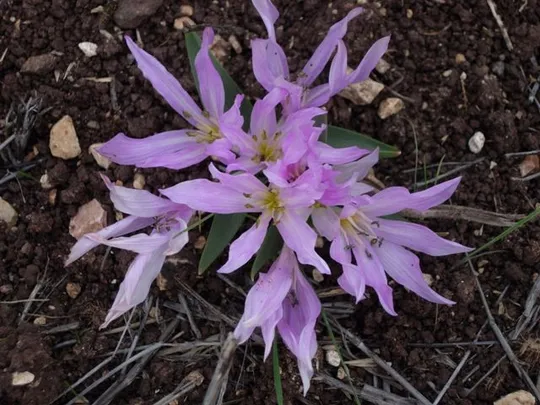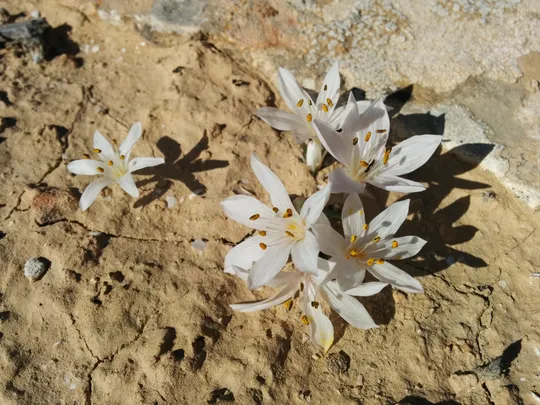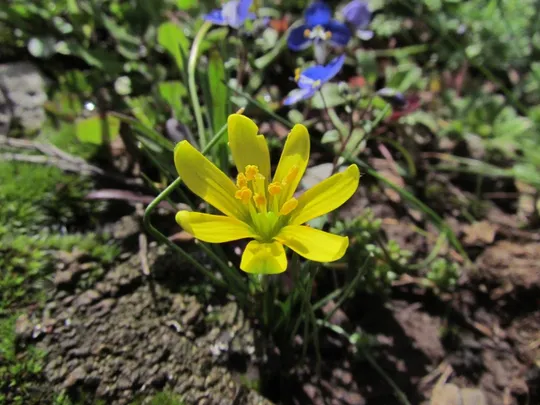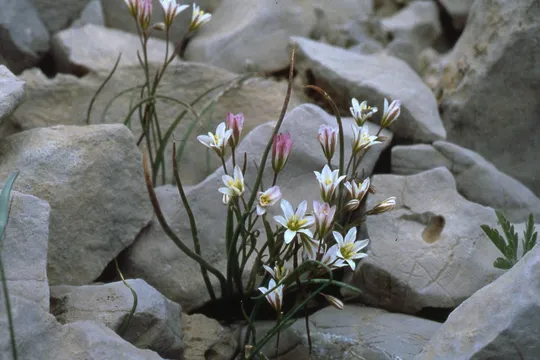Checkered Autumn Crocus
Colchicum feinbruniae
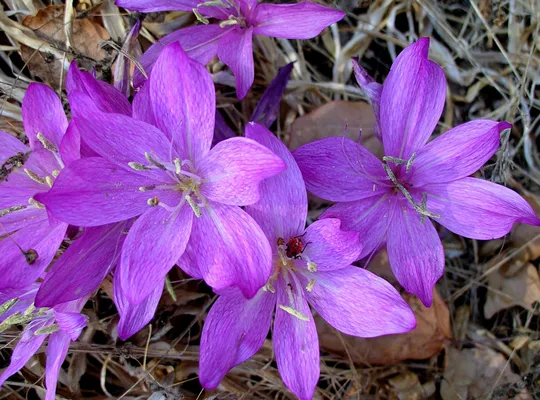
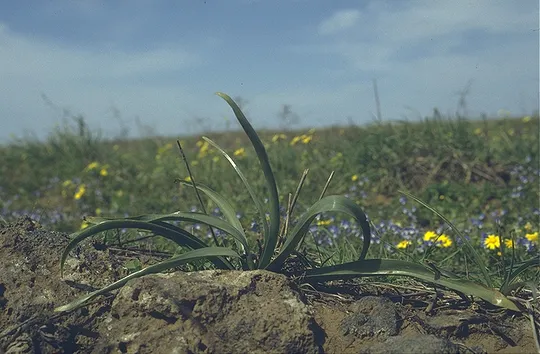
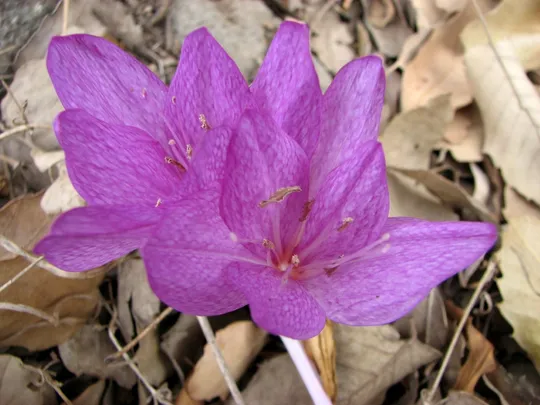
Colchicum feinbruniae is limited to the
Golan Heights and to the foot of Mount Hermon and grows there on 37 sites, of
which 36 sites are located in the central and northern Golan Heights on an area
extending from El Rom in the north to Keshet in the south. According to estimates,
there are about 50 sites. The populations are spread over the Bashanit Ridge,
westwards to Hushnia and Keshet and northwards to Mount Avital and Mount
Bental. Outside this area, there are populations in Waset, Nafah road, Tel
Shiban, Zavitan Stream and more. In the 1980s, an isolated population of C. feinbruniae was discovered on the low Hermon in Wadi Hazuri and in Wadi Govta
at an altitude of 900 m (Orr, 1987). Additional sites on Mount Hermon were
found in Wadi Sna’im on Mount Kahal and near the site of the “covenant between the parts” (Brith ben
HaBetarim) on Mount Dov at an altitude of 900-1300 meters.
Rocky basalt plains with shallow grumosol-like soil at altitudes
of 700-1100 meters on volcanic rocks. Rarely also on limestone rocks and
cliffs.
The genus Colchicum consists of about 90 species distributed
mainly around the Mediterranean Basin and the Middle Eastern mountains. A few
species penetrate to Central Asia and to the Sahara. The center of speciation
is located in Turkey (37 species). Ten species grow In Israel, one of which is
endemic – C. aff. antilibanoticum and three
are sub-endemic: C. tuviae (found recently in
Jordan), C. feinbruniae and C. tunicatum
(the Negev and Edom).
All the Colchicum species in Israel, except for two
(C. ritchii and C. brachyphyllum) bloom in the
fall. Some of the species bloom without leaves such as C. tunicatum, C. hierosolymitanum and C. feinbruniae and others, e.g. C. ritchii and C. stevenii
flower with leaves. Species that flower with leaves are dependent on the first
autumn or winter rains – the flowers and foliage appear only after rainfall
exceeds 8 mm.
C. feinbruniae
is close to C. hierosolymitanum
and differs from it mainly by the dark color of its anthers and by the crisscross pattern of the flower perianth. In addition, the flower
organs of C. feinbruniae are usually larger than those of C. hierosolymitanum, but
not significantly so. In the center of the Golan Heights, there is a
geographical transition in which mixed populations are found (Orr, 1987).
Consequently, C. feinbruniae can be considered as a subspecies
of C. hierosolymitanum. The
two species could probably be combined with C. polyfolia that grows in southeastern Turkey and northern Syria and is very
similar to them (Dusen & Sumbul, 2007).
The number of Colchicum feinbruniae sites
in the Golan is relatively large, but the importance of its conservation results
from its status as endemic to the Golan Heights and an attractive plant whose
spectacular flowers puts it at risk of being collected for transplantation to
gardens. The plant is protected by law by virtue of being a geophyte and grows in
some of the Golan Heights reserves: Bar’on Pond, Mount Shifon, and Bashanit
ridge. The other sites in the Golan Heights are not located in nature reserves.
As the species is endemic to the Golan Heights, its local threat status is
equivalent to its global status.
Long-term population monitoring should be conducted at all
the Colchicum feinbruniae sites and efforts made to obtain
information on the possible existence of populations on Ǧebel Druz and Hauran. Taxonomic-ecologic
research should be conducted on the relationship between C. feinbruniae and the closely related species C. hierosolymitanum and C. polyfolia in Israel, Lebanon and Jordan.
Colchicum feinbruniae is endemic to the
Golan Heights. Persson (1992) identified a single population and first
described the species from Mount Shifon in the Golan Heights. She also noted
the species from Lebanon and southwestern Syria. The taxon range probably
extends to Hauran and Jebel Druze in southern Syria.
Colchicum feinbruniae is a geophyte endemic to the Golan Heights which
has spectacular flowers and should be prioritized for conservation.
י.1987. "לעצור ברמזור ורוד!"- סתוונית התשבץ וסתוונית ירושלים בגולן. "טבע וארץ", ל' (2): 20-22.
Dusen, D. O. and Sumbul, H. 2007. A morphological investigation of chicum L. (Liliaceae) species in the Mediterranean region in Turkey. Turkish Journal of Botany, 31: 373-419
Persson K. 1992. chicum feinbruniae Sp.Nov. and allied species in the Middle East. Isarel J. of Botany.
Current Occupancy Map
| 1000 squre meter pixel | 5000 squre meter pixel | 10000 squre meter pixel | |
|---|---|---|---|
| number of observations | 0 | 0 | 0 |
| in total pixels | 0 | 0 | 0 |
| Family | Liliaceae |
| Classification | On the endangered species list |
| Ecosystem | Mediterranean |
| Chorotype | Mediterranean |
| Conservation Site | Monitoring plot Keshet, Mount Hozek |
| Rarity |
1
1
6
|
|---|---|
| Vulnerability |
0
0
4
|
| Attractiveness |
0
3
4
|
| Endemism |
0
3
4
|
| Red number |
1
4.2
10
|
| Peripherality | N |
| IUCN category | DD EW EX LC CR EN VU NT |
| Threat Definition according to the red book | Endangered |
 Based on:
Based on:
